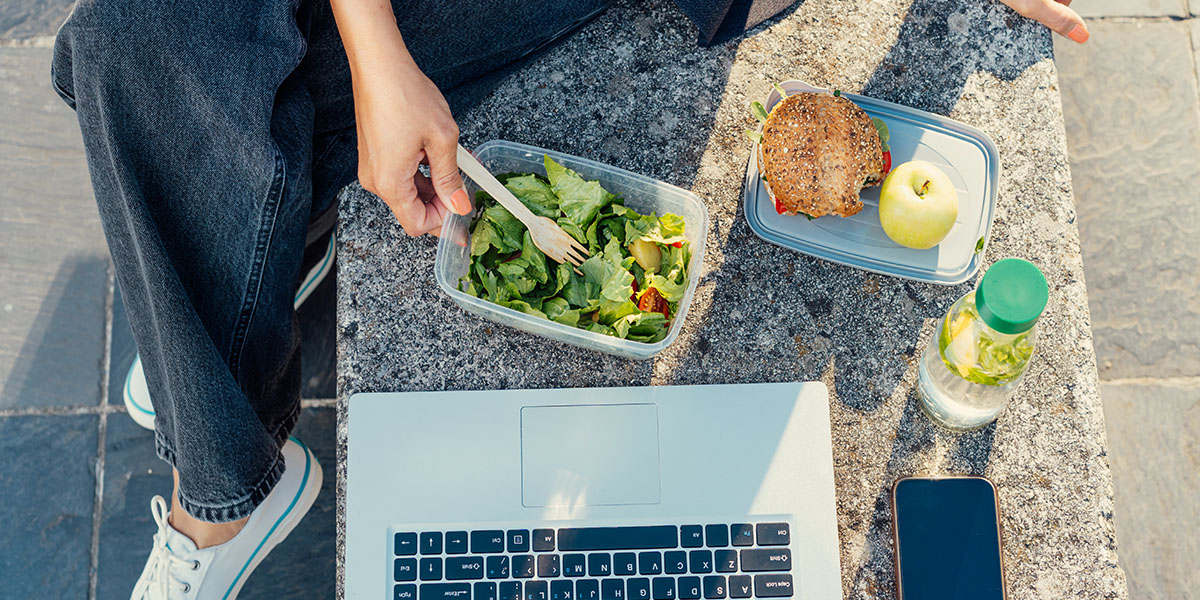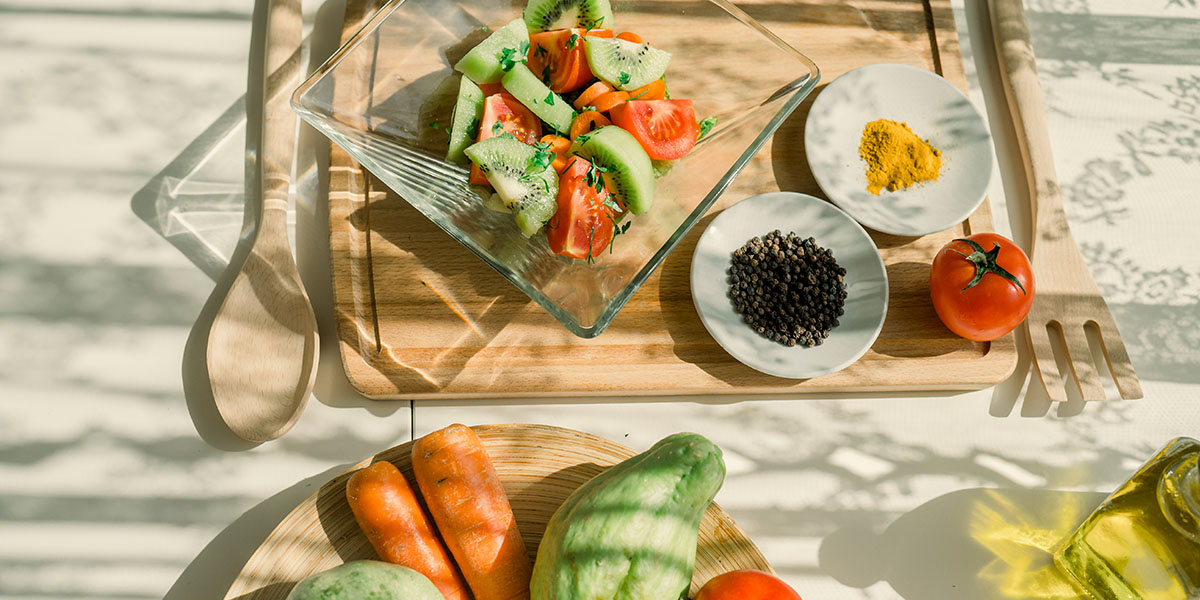Vowing to eat better this year? Some of the most common nutrition resolutions aren’t easy to keep. Here are 3 to skip, and how to replace them.
3 tips for eating healthy at work
Making healthy food choices at work not only helps you feel better, but it can improve your energy and focus. Try these tips to boost your nutrition at work.

Does this sound familiar? You grab a quick coffee on the way to work. You go to back-to-back meetings and eat lunch at your desk. Maybe you even skip it or grab another coffee to get you through the day. Finally, you finish work and realize you feel starved. Instead of a balanced meal, the snacks come out in full swing…
At home or at the office, this is what a typical day looks like for many employees. Skipping meals, being distracted while eating or not planning meals can all lead to poor eating habits, which can have a negative affect on overall health.
Risks to your well-being may include:
- Brain fog.
- Reduced productivity.
- Increased irritability.
- Increased fatigue.
- Increased stress levels.
If we don’t feed our bodies enough during the day, it often leads to:
- Greater hunger in the evenings.
- Food cravings.
- Overeating.
Common eating habits in Canada
Do you think that a lot of people are on top of meal planning and eating meals? You’re in for a surprise.
Here are some eating trends observed in a Canadian Community Health Survey that examined the dietary habits of over 20,000 people:
- Only about 60% of adults and teens eat 3 meals and 1 snack a day.
- About 10% of all Canadians consumed more than half of their calories from snacks.
- Adults and teens are more likely to skip breakfast or lunch.
- Those who tend to skip breakfast are less active.
Distracted eating is also a common habit for many Canadians. Here are some of the top culprits reported in a 2016 study:
- Watching television: 70%
- Browsing the internet: 50%
- Reading a newspaper or magazine: 32%
- Consulting or sharing on social media: 26%
- Sending text messages: 24%
- Working or studying: 21%
- Talking on the phone: 14%
The study also reveals that 1/3 of respondents think lunch is a major chore. When it comes to dinner, 2/3 wait until the day of to decide what to eat, but want their meals to be ready in less than 30 minutes.
If any of this resonates, you are not alone. Taking the time to eat well during our active schedules can be challenging. Here are some realistic ways to overcome workday nutrition woes.
3 tips for eating well at work
1. Plan it out
In the morning, dedicate time for breakfast. If you’re not hungry first thing, plan for a quick snack mid-morning when those hunger signals kick in.
Common signs of hunger include:
- Stomach grumbling.
- Thinking about food.
- Low energy.
- Drop in concentration.
Next, remember that lunch breaks exist for a reason: to eat your lunch! Instead of writing that email or finishing that report, pause to refuel and rehydrate. If you need an extra reminder to commit to your lunch, try blocking off time in your calendar.
Time management is just one aspect of meal-planning. It also involves knowing what to eat. There are many ways to plan your meals, depending on your preferences and lifestyle:
- Prep your meals and snacks. Dedicate one day a week to cooking and preparing meals and snacks for the work week.
- Cook once, eat twice. Cook enough food at dinner, so you have leftovers for lunch the next day.
- Create a weekly meal plan. Take 10-15 minutes to write down the meals you will make during the week.
- Find your frequency. If you do groceries once a week, plan meals for 7 days. If you shop twice a week, plan for a few days at a time.
- Respect your time. Choose meals and recipes that fit in your schedule. For example, 30-minute recipes might be more achievable for a busy parent, as opposed to a 90-minute recipe.
- Stick to what’s familiar. Start with recipes you know how to cook and explore new recipes gradually .
- Embrace kitchen tools. Recipes that use time-saving cooking equipment – like slow cookers or all-in-one pots – can make meal prep more manageable.
- Write it down. Stick your meal plan on the fridge or in another visible spot. Refer to it each day to see:
- what meals are coming up,
- what prep you can do ahead of time,
- or if there’s anything you need to take out of the freezer the night before.
2. Listen to your hunger cues
Our bodies have built-in signals that let us know when to eat and when to stop eating. These are hunger cues, or feeling hungry and feeling full. When we ignore or can’t feel our bodies' biological signals, it can lead to overeating or undereating. This happens to a lot of people during their busy workdays. We are so focused on our tasks that we often ignore or don’t recognize these cues.
If you feel them, don’t ignore them. Monitor which times of the day you feel hungry and plan your meals and snacks at those time. If you don’t feel hunger signals, planning consistent times to eat can help. Pay attention to how your body feels throughout the day and tune in to its cues. Sometimes, we just need to step away from work and take a first bite of food for those signals to kick in.
3. Eat without distractions
Get away from your desk when it’s time to eat. Sit at a table with no electronics or distractions, other than your plate of food. This will help you focus your attention on the task at hand: nourishing your body!
By being mindful and taking your time, you are more likely to eat enough and feel more satisfied. Why? It takes about 20 minutes for signals of fullness to make it from the stomach to the brain. This means that if you rush to finish your meal or if you aren’t paying attention, you might end up overeating or undereating. Both of which can come back to haunt you later in the day.
One welcome distraction, however, is to eat with other people. This can help you slow down your eating as you enjoy conversations between bites of food. It can help give your body the time it needs to signal that you feel full. Not to mention that it’s an effective way to take a mental break and bond with others.
Easy ways to include nutritious foods in your day
Breakfast
Here are some nutritious and delicious options to start your day:
- Cold cereal with milk or plant-based beverage and a piece of fruit.
- Wholegrain toast, bagel, or English muffin with nut butter and banana.
- Oatmeal or kasha made with milk or plant-based beverage topped with frozen berries, nuts , and seeds
- Tip: Try a make-ahead version by mixing the ingredients the night before and leaving it in your fridge.
- Yogurt, cottage cheese, or quark topped with fruit and granola.
- Beans or other pulses with a whole grain carb (like rice, toast, or bulgar).
- Pita, chapati, flatbread, or naan stuffed with a protein (egg, tuna, salmon, cheese, meat, tofu, beans) and veggies.
- Beans and rice (or toast).
- Congee with a protein (egg, chicken, pork, tuna).
- Dumplings stuffed with protein and vegetables.
Lunch and dinner
Try these simple and quick choices to fuel your body:
- Leftovers from a previous meal.
- Wraps. Tortilla, pita, flatbread, or roti stuffed with veggies, protein (egg, tuna, salmon, cheese, meat, tofu, beans). Top with your choice of condiments .
- Bowls. A bed of quinoa, rice, bulgur, or buckwheat topped with greens. Add in some assorted veggies and protein and your choice of dressing.
- Tip: You can prep the ingredients ahead of time in large quantities and assemble your bowl when it’s time to eat.
- Grilled cheese sandwich with a side salad or chopped veggies.
- Pasta salad. Pasta with your choice of veggies, beans or cheese, nuts and seeds, topped with an olive oil and lemon dressing .
- Tip: Prepare all the ingredients while the pasta is cooking to save on time. You can make a big batch and eat it for many meals. It can even be a side dish for another meal.
- Sheet pan meal. Start with a protein like salmon, chicken, sausages or tofu. Add in some potatoes or sweet potatoes. And lastly add some chopped veggies like broccoli, cauliflower, bell peppers and/or Brussels sprouts. Add some seasoning and pop your pain into the oven.
Snacks
Mix and match foods from this list:
- Whole fruits or sliced fruits.
- Nuts and seeds.
- Cheese slices.
- Yogurt, labneh, quark, cottage cheese.
- Fruit and nut granola bar.
- Dips like hummus, babaganoush, tzatziki, guacamole, matbucha.
- Carrot sticks or other sliced veggies.
- Can of tuna, salmon, or sardines.
- Crackers or breads, like pita, naan, roti, chapati, flatbreads, lamajoun.
- Hard-boiled egg (made in advance).
- Muffins, scones, energy balls (made in advance).
Visit Sun Life Healthy you for ideas, tools and tips for developing healthy eating habits.



